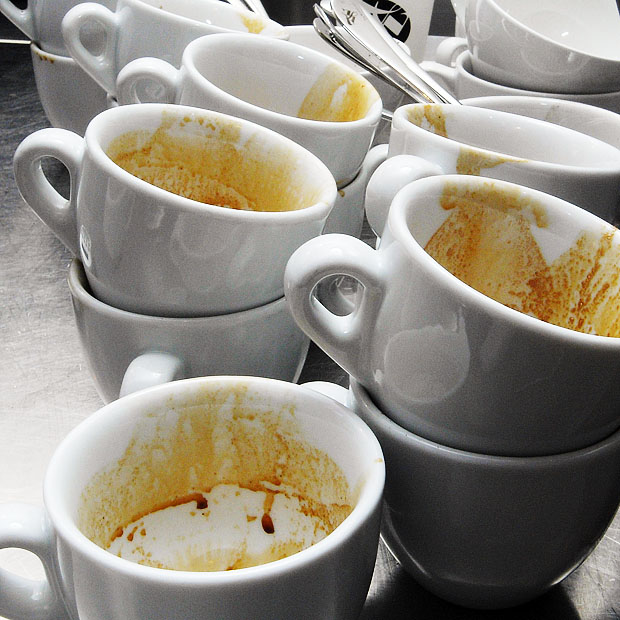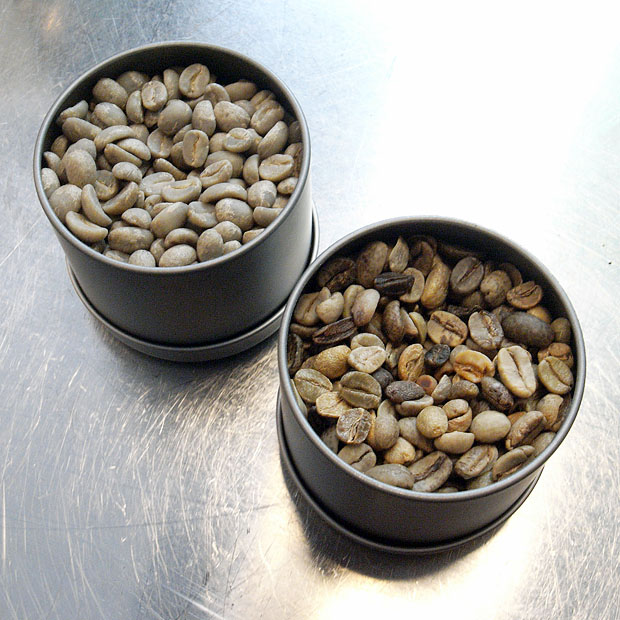
One of the good things about living in Oslo are the coffee bars. Norwegians drink a lot of coffe (a healthy dose of 9.9 kg anually per capita, only second to the Finnish) and perhaps that is one reason why there are so many coffee bars around. One of the best (if not the best) is Tim Wendelboe at Grünerløkka. Tim Wendelboe is a previous WBC champion (2004) who now owns a coffee bar and a micro roastery bearing his name. If you visit Oslo and the Grünerløkka area you should definitely walk the additional 200 m from the crowded “Kaffebrenneriet” at Olaf Ryes plass to his shop. And if you live outside Oslo you can buy freshly roasted coffee directly from his website and read more about his coffee adventures in his blog. If you read Norwegian you might also be interested in his recent book “Kaffe”. I’ve enjoyed a lot of coffee from Tim Wendelboe, both in his shop and as beans at home on my Rancilio, and having finished my post “A pinch of salt for your coffee, sir?” I decided to send Tim an email and ask him about his experiences with salt and coffee. I got a very kind reply were he invited me to come and do some tests in his shop. Now that’s an offer I couldn’t refuse!

The coffee roaster is literarily right in the middle of Tim Wendelboe’s coffee shop at Grünerløkka in Oslo.
In his email reply Tim mentioned that he had heard about salt and coffee, but that he’d never done systematic experiments with it. Interestingly, he also mentioned that in Ethiopia it’s common to serve salted popcorn with coffee! What fascinates me the most from all the comments to my last post is how salt-in-coffee is done more or less around the world. It seems as if many know of it, but hardly ever talk about it!
Measuring the small amounts of salt needed is easy with an analytical balance with a 0.0001 g readout, whereas it is impossible on a scale with a 0.1 g readout (which is what you would typically find in a coffee bar). Therefore, as a preparation I had practiced a little at my work, measuring out salt with a standard spatula. When heaped I’d get around 45 mg of salt, when leveled I typically got 15 mg and with the spatula visible all around the salt I managed to repeatedly weigh out about 10 mg of salt. With this I was ready for some experimenting.

A traditional coffee pot (designed by Grete Prytz Kittelsen) was used for the first extraction.
We started off with a coffee from Square Mile Coffee Roasters, a Colonia San Juan. This is a darker roast compared to Tim’s typical roasts, and he suggested this could be a good starting point to test how salt affects bitterness. Measuring out 65 g of a relatively coarse grind, allowing it to steep in 1 L hot water for 5 min + 1 min (after stirring) and dividing the prepared coffee in three, we then added about 45 mg salt to the first 300 mL of coffee. To the second third we doubled the amount of salt and kept the last as a reference. The first observation was that even at 150 mg/L (corresponding to 45 mg/300 mL) the effect of salt is very noticeable. Tim’s immediate response was that the coffee with salt had lost some of it’s structure, appeared less acidic, had somewhat less bitterness, but at the same time was richer and heavier in the mouth. He’s a pro with years of cupping experience whereas I had my very first go with the cupping spoons, so I’ll never get my experiences down on paper like that. They were definitely different, yet both were drinkable. – This could maybe be useful for cold coffee drinks, says Tim. When cold, the bitterness of coffee becomes more noticeable. One way of combating this is by adding sugar. But with a general consumer trend towards less sugar, a tiny pinch of salt could maybe prove useful. Tim said he’d do more tests, and who knows – maybe this year’s summer special will be an ice coffee with a pinch of salt?

We continued with a newly roasted espresso which hadn’t finished it’s degassing yet, giving it some burnt aromas. The effect of salt (10 mg for a double espresso) were more or less like in the previous test. – It’s as if the one with salt is more viscous, says Tim, adding that he values acidity in espressos and that somehow the salt removes some of this acidity. From the litterature on binary taste interactions it is known that low/medium salt concentrations will enhance sourness whereas higher salt concentrations will suppress sourness. Based on this it sure seems as if we hit the “high” level with respect to sourness (but the experiments we did were of course in no way scientific). I tried one espresso with roughly 2-3 times the amout of salt (20-30 mg for a double espresso). When first tasting it carefully in the front of my mouth I felt it was almost sweet whereas Tim spit it out immediately. I then tasted it again towards the back of my tongue and this time I felt the salty taste too. Quite fascinating how the tasting technique gives different results. These tests also demonstrate how bitterness is linked to and influenced by sourness.
To end it all we tried adding salt to espresso with steamed milk. It turned out that a dose of 10 mg for a double espresso was difficult to discern from the reference. We added more salt and were surprised how much salt could actually be added before it became noticeably salty. But it remains to be seen if salt will make any difference in the end when adding milk. With all it’s proteins, milk is so powerfull in altering the coffee flavor and damping bitterness that a little salt simply won’t make such a big difference.

Apart from the potential use in cold coffee the I guess one conclusion is that high quality coffee from a micro roastery is good by itself. There is no need for salt, but salt can be used to knock out some acidity (as well as some bitterness), resulting in a coffee which is more compact, not so fresh, but with a fuller taste, mellow … and simply different. But as always – more experiments are required. I also think that the effects of salt were best demonstrated with plain hot water extraction. Espressos are so overwhelming and strong that the taste buds quickly tire from tasting a couple in a row. Lastly, I’d also be willing to hypothesize that salt can do more for average (or even poor) coffe beans and/or poor extraction technique than with first class beans prepared in the best possible way. And if you’re in doubt wheter there is a large difference between the quality of coffee beans, take a look at the picture below.

Coffee beans are pale green before they are roasted. The difference between good beans (top left) and bad beans is significant, as Tim showed me. If you think the bad beans are discarded – think again. They’re sorted out one by one and end up in your super bargain coffee!

I wonder if adding salt during the roasting as a ‘salt roast’ coffee would have a different effect, similar to salr toast peanuts or cashews. I could also see a honey roast with salt and honey.
May end up with far too much salt when ground though. I think the way to control dose would be to spray mist the beans at some point during the roasting cycle
What about MSG addition to coffee?
[…] Testing salt in coffee with Tim Wendelboe – (tags: espresso salt ) […]
I read about this a while back and did pretty much what you did for the picture in the previous post: a tiny pinch in the portafilter. It definitely increased the crema and made for a richer, rounder flavor. But the next time around (about half an hour later) I overdid it by the tiniest amount and it was wretched. Less is more.
If you don’t have a scale that can measure 0.0001 g, you can always measure 1 gr, dissolve it in 1 L, and then dosify the proportional amount of ml.
I read this post and the previous one with interest. Growing up in Ontario, Canada, my parents always added a pinch of salt and speck of dry English mustard to the morning pot, a cheap, light-roasted robusta. My father claimed his mother learned to do in the war — a way of adding flavour to cheap coffee. They never bothered for a pot of “evening coffee” — a dark roast — and I guess it was because it wasn’t needed! Thanks for the insights.
[…] Testing salt in coffee with Tim Wendelboe April 8, 2010 RyanTRiddle Leave a comment Go to comments Khymos […]
How curious! Last month I was visiting a friend in Cleveland and he told me about adding a pinch of salt to his coffee and that it smooths out the flavor. He has been doing it for years and asked me to explain the effect. I couldn’t think of anything other that it stimulating the salt receptors to round out the overall flavor. We never did try and scientific test. If salt is indeed inhibiting the bitter receptor, that’s very interesting.
[…] salt, salt. Some quick reading on salt and coffee: Khymos post #1, Kymos post #2. Maybe all my Pegu Clubs need is a pinch of […]
I work at a restaurant called Salt in the USA and we have a salt called Aguni. Its from a small barrier Island of japan and is made by filtering the sea water through Bamboo. We serve this with our coffee and reduces the bitterness. Try it
There’s a tradition in the northern parts of the Nordic countries (Lappland) to add salt to the coffee. Other “thins” that used to be added to coffee was dried skin of pike, it cleared coffee when they boiled coffee using the same grind over and over!
I read about this a while back and did pretty much what you did for the picture in the previous post: a tiny pinch in the portafilter. It definitely increased the crema and made for a richer, rounder flavor. But the next time around (about half an hour later) I overdid it by the tiniest amount and it was wretched. Less is more.
Just saw an article in the US’s NPR (National Public Radio).
http://www.npr.org/templates/story/story.php?storyId=127474607&sc=fb&cc=fp
A coffee company from Taiwan hopes to teach Americans to love squid-ink buns and iced sea salt lattes. Stores in the 85C chain also sell cheap, and unusual, pastries. Just as Starbucks brought venti triple lattes to Main Street, U.S.A., 85C hopes that adding a little saltiness to the caffeine is a hit with American consumers.
“It’s really unique,” says Stephanie Peng, manager of the company’s flagship U.S. store in Irvine, Calif. “The sea salt’s in the cream, the foam part, so it just brings out more coffee essence.”
Hey I appreciate the above post. That is very cool.
[…] If you’d like the opinion of a coffee expert on the matter of salt in your brew, check out this very interesting and informative article on the […]
That is interesting. I never would have thought of adding salt to coffee in the first place. Nor did I realize that it would reduce the acidity of the coffee giving it a more smooth flavor. Great info, I’ll have to try it sometime!